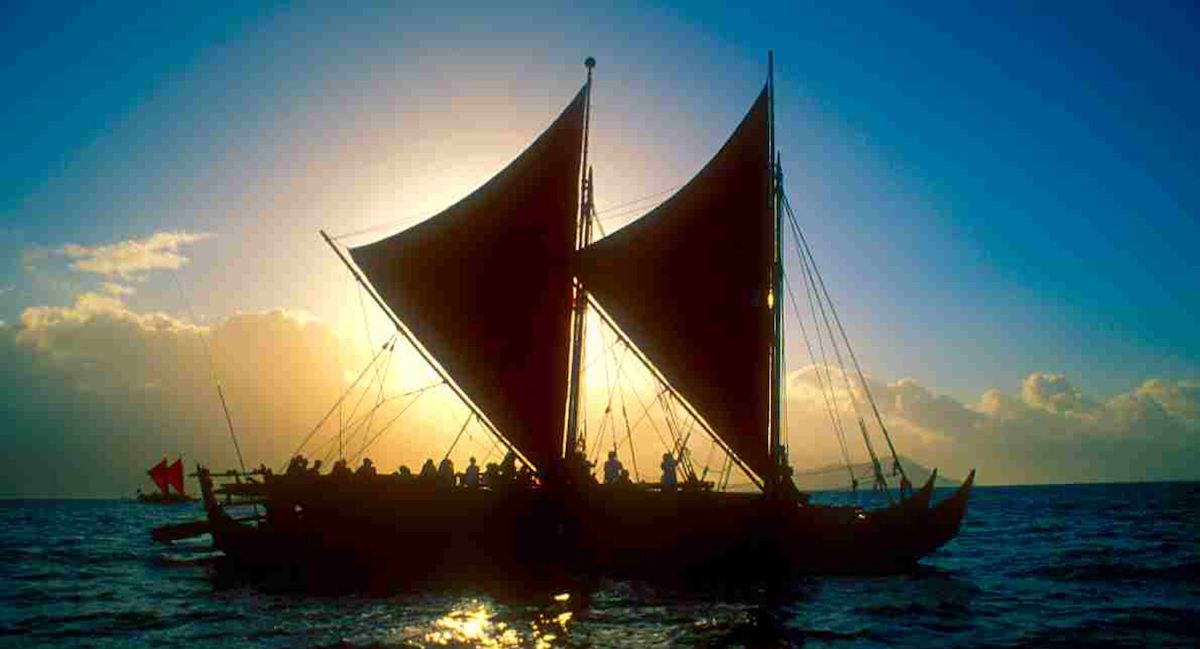A little morning sunshine from New Zealand . . . “Te Vaka Lakalaka” means “We know the way” in Maori-Polynesian. By the way, did you know that the indigenous houses, temples and totem poles of New Zealand are almost identical to those on the Pacific Coast of North America?
by Richard L. Thornton, Architect & City Planner
Uchee (Yuchi) leaders repeatedly told the first British colonists of Georgia that their ancestors came across the Atlantic by boat from the “Home of the Sun” and first settled at the mouth of the Savannah and Ogeechee Rivers. The landscape was uninhabited, but they could tell people had lived there before them. Indeed . . . I can translate most of the tribal names of the Uchee and Muskogee-speaking members of the Creek Confederacy with an Archaic Gaelic dictionary!
Some of these tribes, however, had names that could be translated with either an Archaic Svenska (Swedish) or Archaic Anglisk (English) dictionary! The Angles originally lived in southern Scandinavia. For decades, Georgia anthropologists told us that the many petroglyphs in the Georgia Gold Belt were undecipherable. NOPE! I recognized that they were the same as to those I saw in southern Sweden, while working there long ago. I use a chart of the Swedish Bronze Age writing system, given to me by the Department of Anthropology at Lund University, Sweden, to translate virtually every symbol . . . including the one for “gold.” BTW Bronze Age Swedes were not the modern Germanic Scandinavians, but were Eurasians, who looked like “mixed blood Creeks.”
My non-Polynesian ancestors, the Itstate Creeks, Soque and Apalachete, had Itza Maya or Panoan (Peruvian) tribal names. However, some of those tribes ALSO have names that translate as “Water People” or “Sea People.” In fact, “Soque, Zoque or Sokee” is pronounced exactly like the word that the ancient Scandinavians used for the Sea Sami of northern Lapland and also means “Sea People” in Archaic Norse.
The Muskogee-speaking Creek Indians, use two words for water . . . ue and akwa. Both words are Indo-European. Ue is Illyrian and Iberian. Akwa is Italic and Latin! The Muskogee word for a medical doctor, alek, originally applied to an herbal healer. The Anglisk word for a herbal healer was also “alek”.
There is more to the story, however. Both of my DNA tests said I had significant Polynesian ancestry! My Native ancestors were primarily from the Savannah River Basin and the Caucasians were from Northern Europe. I thought that was weird, but Cousin Ray has found enigmatic information from more recent testing of other family members. Those more sophisticated tests specifically state that the Polynesian portion of our ancestry was MAORI!

Agnetha and Ani-Frid performed at the Midsommersfest Dance, sponsored by Center Party members at Lund University, two years before they became the A’s in ABBA. I went out to dinner with them after the dance then Agnetha “practiced her English” a couple of times afterward. Back then, Agnetha was just a very sweet country girl, who dreamed of singing on Broadway. My past connections with the City of Landskrona and Lund University helped me get assistance from its professors, who initially thought that a Bronze Age Sweden-Georgia connection was totally ludicrous.
A huge oversight by geneticists
None of the standard DNA test markers used around the world by labs to define “Indigenous Americans” came from the Southeastern United States, but by far, that is where the greatest population concentrations were. The De Soto Expedition’s chroniclers stated that they never lost sight of houses or cultivated fields, while traveling through what is now the State of Georgia. Muskogean metropolises, now called Savannah, Ocmulgee, Moundville, Etowah or Coosa, individually had larger populations than all of Alaska at the time of European Contact. Yet the geneticists make broad generalizations based on ancient human remains, unearthed in remote, thinly populated parts of western North America and northern Quebec!
Windover Pond
Florida is the only Southeastern state, whose anthropologists have made a concerted effort to obtain Archaic human DNA. What did they discover? The DNA in the brain matter of the original burials at Windover Pond near Cape Canaveral, FL was identical to that of the people living in Sweden at that time . . . 8,000 to 6,000 BP. Actually, the burial methods were identical too. These peoples are described by Swedish anthropologists as Proto-Sami.
There was another mystery in our family’s DNA. My reports said that I carried substantial Finnish and Sami DNA markers! All of my known European ancestors came from Scotland and Ulster. The Sami and Finnish thing made no sense at all . . . unless one considers that we have known Uchee ancestry from near Savannah . . . in addition to the Northeast Georgia members of the Creek Confederacy. At any rate, the Uchee intermarried a lot with Creeks.
Cousin Ray’s DNA reports went into more detail. Sheezam! The newer DNA reports showed the same combination of Proto-Sami DNA markers that was found in the Windover Pond mummified remains. His father had more Uchee ancestry than his mother, who was my mother’s first cousin. Ray’s family had about double the Proto-Sami DNA that I had. Our interpretation was that the Uchee ancestry was Proto-Sami.
No commercial DNA lab will label that combination of Proto-Sami DNA as Native American. They will tell you that you had Nordic ancestors arrive after Columbus. Yet, having ancestors, who came over the Atlantic 8,000 years ago certainly qualifies as “Native.”
The same problem occurs with Muskogee-speaking Creeks. Muskogee speakers use the same word for “tribe or people” that the Irish and Scots use. Such tribal names as Tokee, Tokwa, Toccoa, Tocohle, Tokasee, Tuckabachee, Currahee, Colasee, etc. are of Scottish Gaelic origin. They were known to have had Asiatic facial features, but often also had reddish-brown hair and freckles. The commercial DNA labs will label all of that archaic Gaelic ancestry as being Post-Columbian, because the orthodoxy is that all Native Americans came over the Bering Land Bridge from Siberia.

The Wassaw People
Wassaw or Wasa are two of the Polynesian words for water or ocean. It was also the name of a major tribe in the Savannah River Basin. Their capital was at Rembert Mounds, near where my mother grew up. Obviously, their first home was on Wassaw Island near Savannah.
The De Soto Expedition entered a Wassaw town near the edge of the Blue Ridge Mountains. They used Late Medieval Castilian spelling to write down its name as Guaxule . . . which in English phonetics would be Washaw-Re = Ocean Tribe. Creek speakers pronounced most S’s like an sh in English and rolled their “R’s” so hard that they sounded almost like a European L. “Re” is the Archaic Gaelic AND Uchee word for a tribe. Re, ree, ly and lee can be seen as the suffix in numerous Irish and Southeastern Native American place names.

Capital of the Wassaw, on the Savannah River in Elbert County, GA
I think that I have figured out why the DNA lab labeled Ray’s family, part Maori. The Maoris appear to have been a branch of the Polynesians, who travelled especially long distances in extremely sturdy catamarans. Perhaps some ended up on the coasts of North America or even northern Europe. One of those Maori bands settled on the Savannah River among ancestors of the Creek Indians. Over time their cultural traditions became quite similar to those of their Muskogean and Uchee neighbors.
And now . . . some entertainment!

I’m
LikeLike
This is funny. The Swedish anthropology professors did not believe me when I said that the same petroglyphs were near where I lived both here in a Georgia and in Sweden. When I sent some photos of the Georgia photographs, one professer became very angry and told me not to contact him again. He said that any educated person would know that the photos were made in Ireland and Southern Sweden. I had to send a photo of the Reinhardt petroglyphic boulder, labeled with the Waleska Georgia location commercially printed on it to the departmental secretary and asked her to send the photo to the professor.
LikeLiked by 1 person